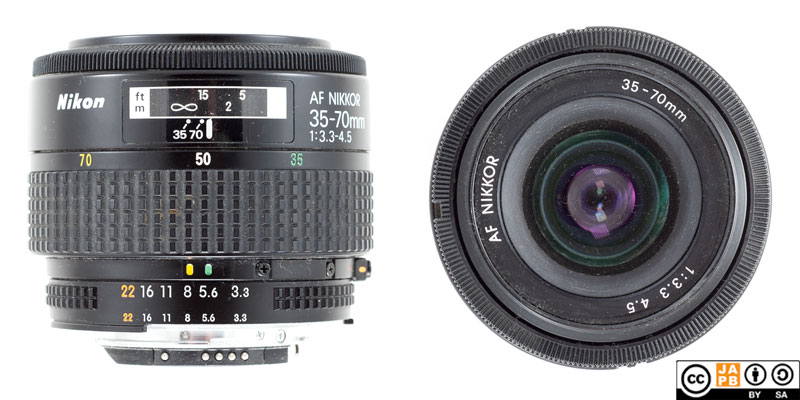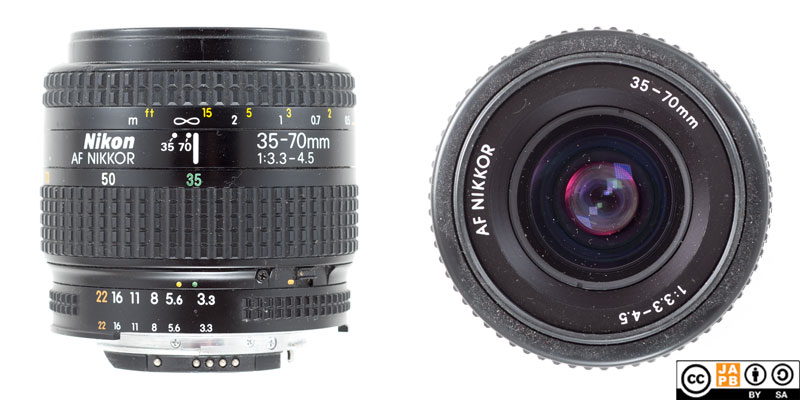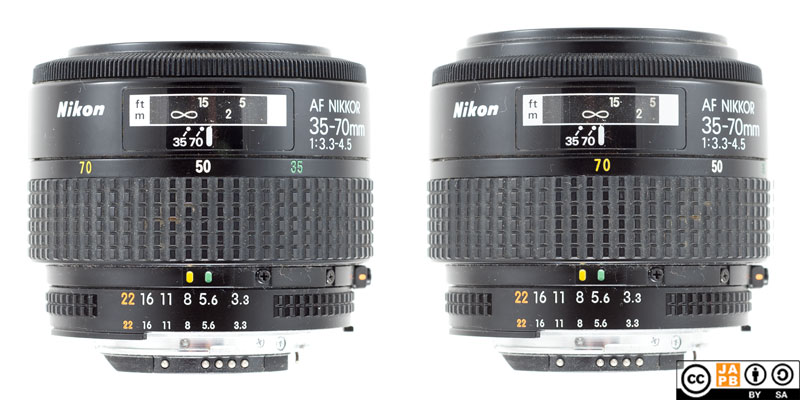Pekka Buttler, 02/2024
Note please: There are two optically identical but cosmetically different versions of this lens:
• Nikkor AF 35-70mm f/3.3–4.5 (1986–1989)
• Nikkor AF 35-70mm f/3.3–4.5 (New) (1989–1994)
(see more under ‘versions‘).
Hence both versions will be addressed in this data one sheet.


Specifications
The table below summarises the lens’ key specifications of both versions (measurements based on pictured samples).
| Brand: | AF Nikkor | Lens name | 35-70mm 1:3.3–4.5 |
| Focal length(s)1 | 35–70 mm | Angle-of-view2 | 62°–34°20 |
| Maximum Aperture | f/3.3–4.5 | In Production | AF 1986–1989 AF (new) 1989–1994 |
| Lens mount | Nikon F | Subfamily (if applicable) | AF |
| Length3 | 56,6 mm 57,9 mm (new) | Diameter4 | 70,8 mm 66,7 mm (new) |
| Filter ring diameter | 52 mm | Weight | 259 grams 247 grams (new) |
| Lens element count | 8 | Lens group count | 7 |
| Aperture blades (S/R/C)5 | 7 S | Focus throw | ≈105 ° |
| Minimum focusing distance | 35 cms | Maximum magnification | 1:4,1 |
| Has manual aperture ring | YES | Has Manual focus ring | YES |
| Aperture mechanism type | Automatic | Aperture click stops 6 | 3.3•5.6-8-11-16-22 |
Historical notes
• When Nikon introduced its autofocus system (the F-501 camera and AF lenses) in 1996, they initially introduced 6 primes (from 24–300 mm), one tele zoom (the 70-210/4 [data sheet]), one macro lens, one autofocusing teleconverter and four lenses corresponding to the definition of a standard zoom:
– Nikkor AF 35–70 mm f/3.3–4.5 (this lens)
– Nikkor AF 35-105 mm f/3.5–4.5 [data sheet]
– Nikkor AF 35–135 mm f/3.5–4.5 [data sheet]
– Nikkor AF 28–85 mm f/3.5–4.5 [data sheet]
• Here there is a clear pecking order, with this lens – the Nikkor AF 35–70mm f/3.3–4.5 – being destined to act as the entry-level kit zoom.
• The first version of the 35–70/3.3–4.5 was cosmetically modernised in 1989 and was given a broader, rubberised focus ring (see above for cosmetic comparison).
• It is important to refer to this as the 35–70/3.3–4.5 as Nikon in 1987 introduced the 35–70mm f/2.8 [data sheet] pro zoom.
Further notes
• No AF-D version of the 35–70/3.3–4.5 was ever made. Instead, the 35–70/3.3–4.5 was replaced by the AF-D Nikkor 35-80 f/4–5.6 in 1994.
• This lens has a manual aperture ring. Also it is of the generation of Nikon AF lenses where autofocus was actually facilitated by a focusing motor in the camera body (not the lens). The lens does not offer controls to switch between manual and auto focus. Instead, this operation would be done on the camera body.
• Nikon did not offer a dedicated, bayonet-mounted hood for the lens. Instead, Nikon recommends using the HN-2 filter thread -mounted hood.
• The lens changes length while zooming. It is at its shortest at the 50 mm setting and lengthens both when moving towards 35 or 70 mm.

Right: Nikkor AF 35–70mm f/3.3–4.5 Zoomed to 70 mm
• The lens’ length also changes when focusing, and the filter thread does rotate when focusing.
• Being intended as a kit-zoom (a.k.a. jack of all trades – master of none), the lens also offers a relatively impressive close-focusing capability of 33 cm (measured) from image plane to subject at 70 mm, leading to a maximum magnification of 1:4,1 (measured)
Versions
The 35–70 mm kit zoom lens was a relatively short-lived design (1984–1994) in the Nikkor lens lineup. During that time, the following three versions were manufactured. Optically they are fundamentally the same design, and share the rather unassuming 8 elements in 7 groups design as well as the minimum focusing distances, as well as several other specs. The table below will highlight the key differences (numbers for the Ai-s lens based on other sources)
| years | manual/ autofocus | diameter | length | weight | focus ring | |
| Ai-s 35–70/3.3–4.5 | 1984-2005 | manual | 63 mm | 61 mm | 255 g | broad rubber ring |
| AF 35–70/3.3–4.5 | 1986-89 | autofocus | 70,8 mm | 56,6 mm | 259 g | very narrow, plastic ring |
| AF 35–70/3.3–4.5 (New) | 1989-94 | autofocus | 66,7 mm | 57,9 mm | 247 g | narrow rubber ring. |
Importantly, the 1984 Ai-s 35–70/3.3–4.5 lens that the two AF-versions were derived from was in itself introduced as the kit zoom for the 1984 Nikon-FG20 manual focus film SLR and was intended as a bottom-rung offering.
Epilogue:
In the mid 1990s Nikon introduced two more film SLRs, named the FE10 and FM10. These were actually not Nikon-designed cameras, but were designed and manufactured by Cosina (to Nikon specifications). Together with these cameras, ‘Nikon’ offered an entry-level zoom lens – the “Zoom-Nikkor 35~70mm 1:3.5~4.8”. This lens is known for three things: its extremely light (under 200 grams) construction; its untypical tele-end maximum aperture (f/4.8); actually also being a Cosina lens rebranded as a Nikkor lens.
A brief genealogy of Nikon SLR lens types
Nikon is undoubtedly one of the great names in 35 mm SLR photography. The Nikon F mount has been in continuous production since 1959. During that time, the mount has developed/changed in some detail, however without ever fully sacrificing compatibility.
In short (a longer version is here), the development of Nikon’s SLR lenses can be traced as follows:
• 1959–1977: Pre-Ai. Manual focus lenses that use ‘rabbit ears’ to communicate selected aperture with the camera body.
• 1977–1986: Ai and Ai-s. Manual focus lenses that may have ‘rabbit ears’ for backward compatibility, but are designed to communicate selected aperture with the camera body through indentations in base of aperture control ring.
• 1986–today: AF and AF-D. Autofocus lenses that do not have a focusing motor within the lens, but rely on the focus motor within the camera. All AF and AF-D lenses are simultaneously Ai-s lenses (they are Ai-s lenses extended with AF) 7
• 1996–today AF-S and AF-P. Autofocus lenses that have an internal focusing motor and do not rely on the body having a focusing motor.
Adapting
Besides adapting, this lens can be used natively on all current high-end Nikon dSLRs and several earlier medium-to-high-end older Nikon dSLRs. Moreover, if the camera body contains a slot-drive focusing motor, this lens will even auto-focus8. Likewise, if the lens has been retrofitted with ‘rabbit ears’, it can be natively used on all Nikon F-mount film cameras ever produced (without the rabbit ears, it is limited to post-1977 bodies).
Thanks to being a fully manual lens (manual aperture, manual focus), the lens can be adapted to all mirrorless cameras using a suitable dumb adapter (and such adapters are easy to find). Moreover, a large range of special adapters (helicoid adapters, tilt/shift adapters, speed boosters) for using Nikon F lenses on most mirrorless systems are available. Currently no adapters for mirrorless exist that would allow autofocus through the slot-drive screw.
Using Nikon F lenses on non-Nikon SLRs and dSLRs is likewise a distinct possibility. Thanks to the relatively generous flange focal distance of the Nikon F mount (46,5 mm), adapter rings for all dSLR mounts are available as well as for a goodly portion of film-era SLR mounts. Such rings will not allow autofocus, and are unlikely to support auto aperture, but even then the lenses can be used in stop-down metering mode.
Footnotes
- Focal length is (unless stated otherwise) given in absolute terms, and not in Full-frame equivalent. For an understanding of whether the lens is wide/tele, see ‘Angle-of-view’. ↩︎
- Picture angle is given in degrees and concerns the diagonal picture angle. Rule of thumb:
> 90 ° ==> Ultra-wide-angle
70–90 ° ==> Wide-angle
50–70 ° ==> Moderate wide-angle
40–50 ° ==> ‘Standard’ or ‘normal’ lens
20–40 ° ==> Short tele lens
10-20 ° ==> Tele lens
5-10 ° ==> Long tele lens
< 5 ° ==> Ultra-tele lens ↩︎ - Length is given from the mount flange to the front of lens at infinity. ↩︎
- Diameter excludes protrusions such as rabbit ears or stop-down levers. ↩︎
- S=straight; R=rounded; C=(almost)circular at all apertures. ↩︎
- Numbers equal aperture values on aperture ring; • intermediate click; – no intermediate click. ↩︎
- There is a further sub-class of AF-D lenses called AF-I lenses that are otherwise AF-D lenses (meaning, fully Ai-s compatible), but have an internal focus motor. Only long tele lenses were made in AF-I variants. ↩︎
- As of this writing, the following Nikon dSLRs fully support autofocus, aperture priority and manual metered modes on Nikkor AF/AF-D lenses: D2, D3, D4, D5, D6, Df, D200, D300, D300s, D500, D600, D610, D700, D750, D780, D800, D800E, D810, D850, D7000, D7100, D7200 ↩︎